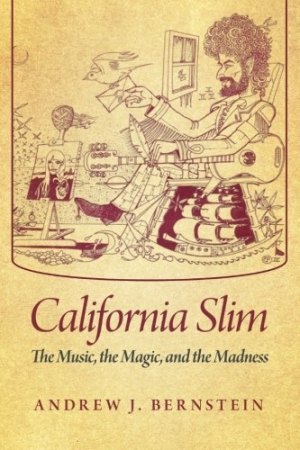California Slim
The Music, the Magic, and the Madness
A behind-the-scenes look at the music industry in the 1960s and ’70s, this fun memoir looks back on the sex, drugs, and rock ‘n’ roll.
Andrew J. Bernstein writes of his front-row seat during the ever-evolving music scene of the 1960s and 1970s in California in California Slim, a very personable memoir that gives a glimpse of what it was like to be a part of rock-and-roll history.
Bernstein was known as California Slim due to his six-foot-seven frame. In 1962, when he was fourteen years old, Bernstein took banjo lessons from a young local musician named Jerry Garcia. This was only the first of many acquaintances with future icons Bernstein made over the years as he parlayed his love of music into several entrepreneurial efforts that helped promote musicians in the early to mid-1970s.
As a high school boy in Palo Alto, however, he recalls being quite the innocent when another student discovered marijuana from an older crowd. “I had no idea what it was, other than from the crappy movies they showed us in health class.” But he was part of the sex, drugs, and rock-and-roll generation, and he embraces it all, telling stories with a sense of humor and sharing his thoughts—set apart in italics—about situations he found himself in. For instance, he meets one of country singer Willie Nelson’s entourage: “A tall thin guy came up to me and whispered in my ear, ‘You earned that tee shirt, man. Pleased to meet ya. I’m Snake, Willie’s personal assistant.’ I’ve never met a snake before…, but, yes, I can see the resemblance.”
Bernstein’s writing is on the mark: a friendly, what-you-see-is-what-you-get style. He gives background information with little effort, and it adds to the complete picture, especially when it comes to the various incarnations of bands. He writes nonchalantly about the talent at a local downtown club: “Young rock bands, like The Gollywogs, out of El Cerrito, just north of Berkeley, were regulars there. Within a year, the Wogs would change their name to Credence [sic] Clearwater Revival and release their first album.”
Chapters have fun but relevant titles such as “The Smell of Diesel in the Morning.” The book is peppered with photos nearly every two to three pages, including some of bands at their very beginnings. Most of the photos are black-and-white originals from the author’s personal collection and add a great visual element. Above each chapter title is the logo of one of Bernstein’s first solo businesses, Half Gaffed Productions. Adding ambiance to the time and locale are copies of the hand-drawn posters used to announce the concerts Bernstein writes about. For some of them, he provides the musicians’ playlists too.
The second half of the book deals with his friendship with Nelson as he begins his rise in popularity. This is a behind-the-scenes look at moving from small venues to big concerts, with quite a cast of characters along for the ride, especially if Bernstein is providing the bag of material everyone wants “to burn.”
California Slim is an unvarnished look—with lots of adult language—at an iconic time in music history. Or, as Bernstein facetiously puts it after a successful rock-and-roll show at his club, “Once we locked up, we got together [with the band] in the Purple Room for tea and crackers until at least 3:00 A.M. Nobody remembered too much about it the next afternoon.”
Reviewed by
Robin Farrell Edmunds
Disclosure: This article is not an endorsement, but a review. The publisher of this book provided free copies of the book and paid a small fee to have their book reviewed by a professional reviewer. Foreword Reviews and Clarion Reviews make no guarantee that the publisher will receive a positive review. Foreword Magazine, Inc. is disclosing this in accordance with the Federal Trade Commission’s 16 CFR, Part 255.

